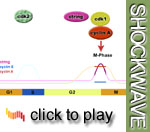Molecular basis of cell division
 Cyclin dependent kinases (cdk): Cyclin dependent kinases drive the
cell into the next phase of the cell cycle, either S-phase or mitosis, by
phosphorylating diverse target proteins. Different cdk proteins regulate
different cell cycle phases. Although the concentration of cdks usually
remains constant throughout the cell cycle, they are activated only at defined
cell cycle phases. As their name suggests, they are associated with another
type of molecules, the cyclins, which are required for cdk activation.
Cyclin dependent kinases (cdk): Cyclin dependent kinases drive the
cell into the next phase of the cell cycle, either S-phase or mitosis, by
phosphorylating diverse target proteins. Different cdk proteins regulate
different cell cycle phases. Although the concentration of cdks usually
remains constant throughout the cell cycle, they are activated only at defined
cell cycle phases. As their name suggests, they are associated with another
type of molecules, the cyclins, which are required for cdk activation.Cyclins: Cyclins act as subunits of the cyclin dependent kinases. In the prototype cell cycle, their concentration changes periodically over time – hence the name “cyclin”. Their concentration is regulated both transcriptionally and through periodic proteolysis.
Different combinations of cyclins and cyclin dependent kinases regulate the progression through different phases of the cell cycle. For example, cyclin A or cyclin B in complex with cdk1 (also called cdc2) are required for the entry into mitosis in Drosophila, whereas cyclin E together with cdk2 regulates the onset of DNA replication. Just as activation of the mitotic cdk1 through complexation with cyclinA and cyclinB promotes mitosis, destruction of the cyclins and thereby inactivation of the kinase is required for completion of mitosis. If the proteolytic degradation of cyclins is impaired, cells arrest in mitosis.
Kinases and phosphatases regulating cdks: In addition to their regulation by cyclins, the activity of cyclin dependent kinases is controlled through phosphorylation. In Drosophila, the string phosphatase removes inhibitory phosphates from the ATP binding site of cdk1.
Media list